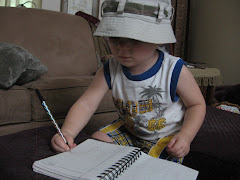1. BIBLIOGRAPHY
Uhlberg, Myron. DAD, JACKIE, AND ME. Illustrated by Colin Bootman. Atlanta: Peachtree, 2005. ISBN 1561453293.
2. PLOT SUMMARY
In the summer of 1947, the Brooklyn Dodgers made history when they signed new first baseman Jackie Robinson. Jackie’s grace under fire of prejudice and discrimination is inspiring to one young white boy and his deaf father who begin to go to Dodgers’ games to watch and cheer for Jackie during this special summer.
3. CRITICAL ANALYSIS
Told in first person, Myron Uhlberg delivers a wonderful story of a boy who “was glued to the radio, like every other ear in Brooklyn” on the opening day of the 1947 baseball season, the first season where a black man plays for a major league team. When his father comes home with tickets to a Dodgers’ game, and the boy gets to see Ebbets Field for the very first time, he knows he will never again see anything as beautiful. But many in the crowd yell at Jackie, calling him horrible names, and other players treat him disrespectfully. Additionally, the boy is a little embarrassed by his father who begins yelling for Jackie. The boy’s father is deaf and his call of “Jack-ie, Jack-ie” comes out more like “AH-GHEE, AH-GHEE” causing the crowd around them to stare at him. Yet as the game progresses, father and son notice the grace with which Robinson plays, ignoring the taunts and names, and the boy notices that the crowd is paying less and less attention to his father as well. This story progresses through the entire season, ending with a surprising and touching final scene at the last game.
The watercolor paintings by Bootman are simply magical. My favorite might be a sequence scene in the painting where Robinson is up to bat, hits the ball, and slides into base. (This book has no page numbers). The illustrations throughout support the text nicely, in once instance even giving me the meaning of a term I was not familiar with. During a Cardinal / Dodger game, a Cardinal crossed first base and “spiked” Jackie on purpose. The painting clearly shows the Cardinal player stepping squarely on Robinson’s leg, the spikes from his shoe going into his ankle as he gets to first base knowing he’s going to be out. Bootman, who has won the Coretta Scott King honor award for his illustrations in Almost to Freedom does a superb job here as well. Facial expressions are genuine, skin coloring is varied, street and crowd scenes are complex and full of detail, and his portrayal of the game are spirited and lively.
At the end of the story, Uhlberg, in his “Author’s Note,” explains that this story is fiction with some grounding in real life. His father and mother were both deaf, and his father took him to many games. His father explained that Jackie would have a chance to show the world that he is as good as they are, despite the color of his skin. That note also goes on to tell the story of another baseball player, William Ellsworth Hoy, who was deaf and proved that he was as good as – actually even better than – any other baseball player. The hand signals used by umpires to signal balls and strikes was a direct result of Hoy’s efforts. (Did other hand signals used in baseball come about as a result of Hoy as well? Perhaps that is also a direct descendent of the balls/strikes signals, but the note doesn’t say.) The endpapers of the book are reproductions of scrapbook pages with actual newspaper articles and pictures taped in.
An excellent read-aloud for younger children, and a great addition to any collection that can be accessed by baseball fans of any age, this story weaves fact and fiction together into a wonderful story of perseverance under adversity.
4. REVIEW EXCERPTS
*Publishers Weekly: “Ultimately, this is an affecting tribute to Robinson, to a dedicated son and to a thoughtful, deep-feeling father. And, of course, to baseball.”
*School Library Journal: “Bootman's lovely watercolor paintings add detail and wistful nostalgia. Baseball fans may be disappointed with the narrative's slow pace and the fact that Robinson is little more than an iconic figure, but others will appreciate the story's insightful treatment of deafness as viewed through the eyes of a child.”
*Children’s Literature: “Bootman’s watercolor illustrations work beautifully in conjunction with the text to bring to life the 1940s neighborhood and Ebbets Field. He has successfully captured the emotions of the story and the action on the baseball diamond. This is a fine book for fathers and sons to share together, and a thought-provoking piece for a middle school or a high school class to share together. Readers can glean an interesting perspective on history from the newspaper clippings and the photographs that comprise the scrapbook end papers.”
*Library Media Connection: “The discrimination shown to Jackie Robinson, the first black baseball player, as well as the prejudices against his hearing impaired father are sensitively written. Robinson's determination to overcome thoughtless intolerance in order to prove himself worthy parallels the life of the author's father in his everyday trials. This is a great read-aloud and discussion starter for its historical information and emotional treatment of inequality.”
5. CONNECTIONS
• Research Jackie Robinson. This story actually uses Robinson as background for the central story of the boy learning about his father, so more information about Robinson’s time as a major player might be interesting to older students, particularly those who love sports.
• Depending on the age of the readers, research into prejudice and discrimination during his years in major league baseball.
• Research deafness. What difficulties and challenges have deaf people historically had to overcome. (The book talks about how deaf people were labeled as “dumb,” and deaf children weren’t thought to be able to participate in athletics.) Learn to finger spell a simple, positive message.
GUEST POST: Chris Baron on SPARK
6 months ago




